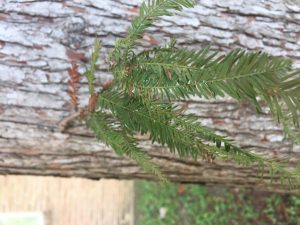I have been observing a tree located outside of my dorm hall building for the semester. I have gone to this location multiple different times, at different times during the day to record my findings. In the first couple weeks I was working to identify the species that are in this area. I concluded that this tree is an Acasia Fernansia. I was able to look at pictures I had taken of the bark and the leaves or my tree and make a guess that this is what it is. I used native Texas tree website to attempt to identify the tree. I also was able to spot a few animals and insects around my tree. My tree has very thin branches with sparse leaves not making it a good location for squirrels and birds to be. There were squirrels around the bottom of the tree in the mulch though. I have concluded that these squirrels are Eastern Grey Squirrels. I was able to conclude that by looking at their coloring and observing them and then looking at an online resource of what species are around Austin Texas. Some of the insects i had identified are the yellow garden spider and many kinds of ants. I was able to identify this spider by seeing the web and researching the patterns. All of my hypothesis about these species are my best guess at what they could possibly be.
In the following few weeks since my last blog post I have continued to observe this location and see if I am able to identify any changes. From the research i conducted on the Acacia Fernasia I was suspecting that the leaves would start to change color slightly as the season went on and it got cooler. Throughout the semester I didn’t see many physical changes of my tree or its location. This is possibly because of how short of a time I was observing this location. It would be interesting to see if after a year this tree changes with the seasons. The animals on and around the tree didn’t change much either, they remained constant over the semester. The only observable change was that the mulch below was growing many more weeds and grass later in the semester due to the amount of rain we had. The tree and surrounding plants were thriving off of all of the water that was being supplied.
One pattern I was able recognize from observing this location is the presence of wildlife was more visualant at night. As I said earlier, I chose a good location for me to be able to see because throughout the semester I was able to look out my window and see. This was helpful when trying to look at what was happening at night. The animals barely came during the day and routinely to look for food at night. Another hypothesis I have for why the wildlife is limited is because of the lighting. This location is constantly under the lights of the building which could influence the animal’s choice in choosing a different tree.
To conclude, observing this tree was interesting and I feel I picked a good location. I was able to make a lot of findings about the wildlife scene on campus and was able to connect this to what we talked about in class, how cities affect wildlife. This is a popular question at the moment as the urban areas are expanding all over the world and wildlife conservation is being taken more seriously. More people are realizing how many animals are extinct or endangered and taking action to research their decline and preserve them. Observing the wildlife on campus is relative to this question because it is located right around an urban area.

“Tillandsia Recurvata.” Wikipedia, Wikimedia Foundation, 29 Aug. 2017, en.wikipedia.org/wiki/Tillandsia_recurvata.
Wegner, Gerry. (2010). Eastern Gray Squirrel. Pest Management Professional, 78(4), 63.
Wasowski, S., & Ryan, J. (1985). Landscaping with native Texas plants. Austin, Tex.: Texas Monthly Press.
